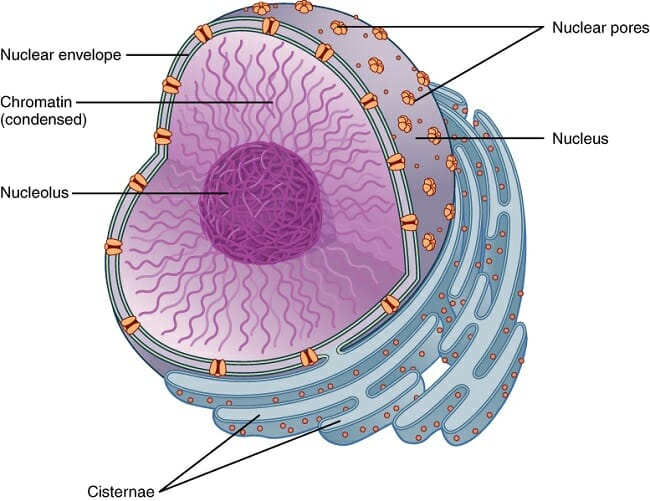Class 10 - Science
Chapter 15 - Our Environment
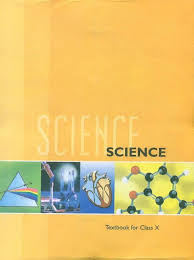
Top Block 1
Page 257
Question : 1. Why are some substances biodegradable and some non-biodegradable ?
Answer :
Substances that are broken down by biological processes are said to be biodegradable. In our environment, many of the substances are broken easily by decomposers (bacteria and fungi) as they possess specific enzymes for such activity. However, there are other substances also which are not broken down in this manner and are known as non-biodegradable substances. Since these substances are not degraded by bacteria and fungi, so they persist for a long time. These non-biodegradable substances will be acted upon by physical processes like heat and pressure.
Question : 2. Give any two ways in which biodegradable substances would affect the environment.
Answer :
1. They may produce foul smell during decomposition process.
2. They may produce some harmful gases such as ammonia, methane, carbon dioxide, etc., which can further-cause global warming.
Question : 3. Give any two ways in which non-biodegradable substances would affect the environment.
Answer :
1. These inert substances simply persist in the environment. This means that these substances require land area for dumping.
2. Excess of fertilizers, pesticides and other chemicals changes soil chemistry and also affects aquatic life.
3. Most of these chemicals and heavy metal are easily absorbed by the organisms. This causes biological magnification.
Page 261
Question : 1. What are trophic levels? Give an example of a food chain and state the different trophic levels in it.
Answer :
Each step or level of the food chain forms a trophic level. Consider the following food chain:
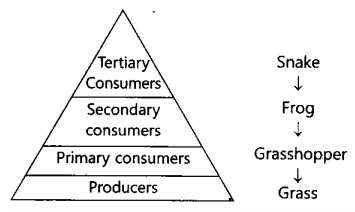
Question : 2. What is the role of decomposers in the ecosystem?
Answer :
Role of decomposers in the ecosystem :
1. They help in breaking down the complex organic into simple inorganic that go into the soil and are used up by the plants.
2. They the nutrient pool of the putting In this way, ad as cleansing agents of nature.
3. They help in maintaining the fertility of by adding humus content to it.
Page 264
Question : 1. What is ozone and how does it affect any ecosystem?
Answer :
Ozone (O3) is a molecule formed by three atoms of oxygen. At the higher of the atmosphere, it shields the surface of the earth from ultraviolet (UV) radiation from the Sun. It may affect any ecosystem in the following ways :
1. At the surface of the earth, it is a deadly poison for all lower forms of life.
2. If this layer gets depleted, then it may cause cancer in human beings including other plants and animals.
Question : 2. How can you help in reducing the problem of waste disposal? Give any two methods?
Answer :
1. By changing our lifestyle and change in attitude will reduce disposable waste.
2. Reducing packaging.
3. Recycling of waste.
4. Preparing compost of biodegradable waste.
Multiple Choice Questions
Question : 1. Which of the following groups contain only biodegradable items?
(a) Grass, flowers and leather
(b) Grass, wood and plastic
(c) Fruit-peels, cake and lime-juice
(d) Cake, wood and grass
Answer :
(c) Fruit-peels, cake and lime-juice and (d) Cake, wood and grass
Question : 2. Which of the following constitute a food-chain?
(a) Grass, wheat and mango
(b) Grass, goat and human
(c) Goat, cow and elephant
(d) Grass, fish and goat
Answer :
(b) Grass, goat and human
Question : 3. Which of the following are environment-friendly practices?
(a) Carrying cloth-bags to put purchases in while shopping
(b) Switching off unnecessary lights and fans
(c) Walking to school instead of getting your mother to drop you on her scooter
(d) All of the above
Answer :
(d) All of the above
Question : 4. What will happen if we kill all the organisms in one trophic level?
Answer :
If we kill all the organisms in one trophic level, then transfer of energy as well as matter to next higher level will stop. It will lead to over- population at one particular level causing amongst the individuals. This would seriously disturb the food chain and can cause the collapse of an ecosystem even.
Question : 5. Will the impact of removing all the organisms in a trophic level be different for different trophic levels? Can the organisms of any trophic level be removed without causing any damage to the ecosystem?
Answer :
Yes, the impact Of removing all the Organisms in a trophic level will be different for different trophic levels. It will not be possible to remove any organism in any trophic level without causing damage to the ecosystem.
Question : 6. What is biological magnification? Will the levels of this magnification be different at different levels of the ecosystem?
Answer :
The accumulation of harmful chemicals in the body of living organisms at different trophic levels in a food chain is called biological magnification. Yes, the concentration of these harmful chemicals will be different at different trophic levels. It will be maximum at the last trophic levels which is mostly of the top carnivores (quaternary consumers).
Question : 7. What are the problems caused by the non-biodegradable wastes that we generate?
Answer :
(i) Non-biodegradable wastes persist in the environment for a long time and cause greater harm to the various members of the ecosystem by causing biological magnification.
(ii) Non-biodegradable waste such as fertilizers, pesticides, weedicides, etc., changes the soil chemistry. in turn affects the fertility of soil and subsequently reduces the crop yield.
Question : 8. If all the waste we generate is biodegradable, will this have no impact on the environment?
Answer :
Biodegradable waste will be recycled easily by the decomposers such as bacteria and fungi. It will have only this bad impact on our environment that, many Of the gases released during decomposition process may result in global warming.
Question : 9. Why is damage to the ozone layer a cause for concern? What steps are being taken to limit this damage?
Answer :
The ozone shields the surface of the earth from ultraviolet (UV) radiation from the sun. These radiations are highly damaging as they can cause cancer in both plants and animals, damage to eyes and immune system. They can also lead to variations in global rainfall, ecological disturbances and dwindling of global food supplies. Due to these reasons, damage to the ozone layer is a major cause for concern.
Steps which are taken to limit this damage :
1.
1. To decrease the use of synthetic chemicals like chlorofluorocarbons (CFCs) which are used as refrigerants and in fire extinguishers.
2. In 1987, the United Nations Environment Programme (UNEP) succeeded in reaching an agreement to freeze CFC production at 1986
Multiple Choice Questions
Question : 1. Identify the original source of the energy which flows through a food chain?
(a) Carbon dioxide
(b) Glucose
(c) Oxygen
(d) Sunlight
Answer :
(d) All the living organisms get energy directly or indirectly from the sunlight reaching the surface of Earth.
Question : 2. A teacher draws the pyramid of energy on board and writes A, B, C and D, in each trophic level as shown in the diagram given alongside. Which level represents the herbivores?

Mddle block 1
(b) B
(c) C
(d) D
Answer :
(c) The trophic levels represent the transfer of food or energy through various steps or levels in the food chain. Producers harness the maximum energy followed by primary consumers, i.e. a herbivore, which is represented by C in thg given diagram.
Question : 3. Which of the following groups contains only biodegradable items? [NCERT]
(a) Grass, flowers and leather
(b) Grass, wood and plastic
(c) Fruit-peels, cake and lime-juice
(d) Cake, wood and grass
Answer :
(a), (c) and (d) substances that are broken down (decomposed) by the biological processes are said to be biodegradable e.g. fruit-peels, cake, lime-juice, wood, grass, leather, flowers, etc.
Question : 4. Which of the following constitutes a food-chain? [NCERT]
(a) Grass, wheat and mango
(b) Grass, goat and human
(c) Goat, cow and elephant
(d) Grass, fish and goat
Answer :
(b) Each step of food chain form a trophic level. Producers (grass) forms the first trophic level, herbivore (goat) the second and carnivore (human) the third trophic level.
Question : 5. Which of the following are environment- friendly practices? [NCERT]
(a) Carrying cloth-bags to put purchases ‘ while shopping .
(b) Switching off unnecessary light and fans
(c) Walking to school instead of getting your mother to drop you on her scooter
(d) All of the above
Answer :
(d) Cloth-bags are biodegradable, switching off unnecessary light and fans conserves electricity and limited use of petrol/diesel causes less pollution. Hence, all these practices are considered as environment friendly.
Question : 6. Which of the following statements about food chain are correct?
(a) It includes repeated eating, i.e. each group eats the other and is subsequently eaten by some other group of organisms.
(b) It shows a series of branching lines and unidirectional flow of energy.
(c) It shows the unidirectional flow of energy and proceeds in a progressive straight line.
(d) Both (a) and (c)
Answer :
(d) A food chain is a series of organisms in an environment through which energy transfer occurs starting with a producer. It proceeds in straight line. Food chain does not consist of branching lines.
Question : 7. In class, the teacher explained the concept of food chain and energy flow. She made a diagram as given below and asked the students to identify the producer organism in the chain. What do you think will be the student’s answer?

Answer :
(b) Cabbage is the producer component of this chain. It produces food using sunlight and other components by photosynthesis process. Others are all consumers.
Question : 8. An ecosystem includes
(a) all living organisms
(b) non-living objects ,
(c) both living organisms and non-living objects
(d) sometimes living organisms and sometimes non-living objects
Answer :
(c) All the interacting organisms in an area taken together with the non-living constituents of the environment form an ecosystem. Thus, an ecosystem consists of biotic components including all living organisms and abiotic components constituting physical factors like temperature, rainfall, wind, soil and minerals.
Question : 9. In the following groups of materials, which group (s) contains only non-biodegradable items?
(i) Wood, paper, leather
(ii) Polythene, detergent, PVC
(iii) Plastic, detergent, grass
(iv) Plastic, bakelitC DDT
(a) (iii)
(b) (iv)
(c) (i) and (iii)
(d) (ii) and (iv)
Answer :
(d) Substances that cannot be broken down by biological processes in nature are non-biodegradable. e.g. polythene, detergent, PVC, plastics, bakelite, DDT, etc. On the other hand, substances that are broken down (decomposed) by biological processes are said to be biodegradable, e.g. wood, paper, leather, grass, animal bones, etc.
Question : 10. Which of the following statement is incorrect?
(a) All green plants and blue-green algae are producers.
(b) Green plants get their food from organic compounds.
(c) Producers prepare their own food from inorganic compounds.
(d) Plants convert solar energy into chemical energy.
Answer :
(b) Green plants prepare their food from inorganic compounds using radiant energy of the sun in the presence of chlorophyll. All green plants and blue-green algae are called producers as they can prepare food from inorganic substances by photosynthesis. Producers capture the solar energy and convert it into chemical energy.
Question : 11. What will happen if deer is missing in the food chain given below?
Grass → Deer →Tiger
(a) The population of tiger increases.
(b) The population of grass decreases.
(c) Tiger will start eating grass.
(d) The population of tiger decreases and the population of grass increases.
Answer :
(d) If deer is missing in the given food chain, there will not be sufficient food for the tigers. Some of the tigers will die because of starvation and hence, the population of tigers will decrease. Since, grass is eaten by deers, the population of grass will also increase whefl deer is missing.
Question : 12. In a class activity, two students were asked to collect different items from their fellow mates and classify them as biodegradable and non- biodegradable. All the items have been identified except three. Find out which one is non-biodegradable among these?
(a) Jute crafted bag
(b) A sharpner
(c) Empty fevistick
(d) Both (b) and (c)
Answer :
(d) Both (b) and (c), i.e. the sharpener and the empty fevistick container. These products are made from plastic and hence are non-biodegradable.
Question : 13. The diagram shows excretory losses from a rat to the environment.
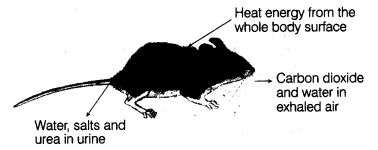
(a) carbon dioxide
(b) heat energy
(c) salts
(d) urea
Answer :
(b) Heat energy cannot be recycled, it gets lost in the environment. The generated is returned through the carbon cycle. Salts are used by living organisms present in the ecosystem. Urea also returns to the nitrogen cycle.
Question : 14. Which of the following limits the number of trophic levels in a food chain?
(a) Decrease in energy at higher trophic levels
(b) Deficient food supply
(c) Polluted air
(d) Water
Answer :
(a) Decrease in energy at higher trophic levels limits the number of trophic levels in a food chain. At each trophic level, a large portion of energy is utilised for the maintenance of organisms that occur at that trophic level. So, organisms at higher level gets less and less energy at successive levels. The.number of trophic levels are limited to 3-4 because after that, the energy available for the next level will be too small, i.e. it will be insufficient to sustain life of the organisms.
Question : 15. If a grasshopper is eaten by a frog, then the energy transfer will be from
(a) producer to decomposer
(b) producer to primary consumer
(c) primary consumer to secondary consumer
(d) secondary consumer to primary consumer
Answer :
(c) In a food chain, if a grasshopper is eaten by a frog, then the energy transfer will be from primary consumer to secondary consumer. Grasshopper feeds on producers i.e. the grass/plants. So, it occupies the level of primary consumer. Frogs, eating grasshopper thus become the secondary consumer.
Question : 16. In the given food chain, suppose the amount of energy at fourth trophic level is 5 kJ, what will be the energy available at the producer level?
Grass → Grasshopper → Frog → Snake → Hawk
(a) 5 kJ
(b) 50 kJ
(c) 500 kJ
(d) 5000 kJ
Answer :
(d) According to 10% law, only 10% of the energy entering a particular trophic level of organisms is available for transfer to the next higher trophic level. In this food chain, at the 4th trophic level, only 5 kJ energy is available to the snake. So, the energy available at the producer level will be 5000 kJ.
It can be shown as
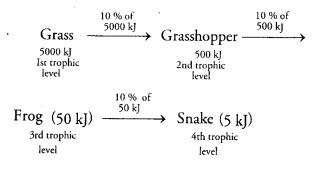
Additional Questions
Question : 1 Define environment?
Answer :
The biotic and abiotic factors which surrounds any living organism is considered as its environment. It can be generally defined as a community of organisms living in a particular environment and the physical elements in that environment with which they interact.
Question : 2 What is a food chain?
Answer :
The process of eating autotrophs by herbivores and herbivores being eaten by other animals is
Question : 3 List out the components in a food chain?
Answer :
The various components of a food chain include 1. Plants 2.Herbivores 3.Carnivores and4. Decomposers. Each of these is placed in different trophic levels.
Question : 4 What is a food web?
Answer :
Interconnected food chains form a food web.
Question : 5 What is pollution?
Answer :
Any undesirable change in the environment is considered as pollution. The change may be in the air, water, or soil.
Question : 6 Explain the effects of human activity on the environment?
Answer :
Any type of change that people make in our environment affects the animals, plants and the land. Some changes are helpful. Some may be harmful to the environment.
Clearing land for farming, construction of homes, roads, and shopping centers is helpful to people, but animal habitats and plants may be destroyed. Clearing of land may result in soil erosion and the eventual loss of topsoil.
Question : 7 Define ozone layer?
Answer :
Ozone is a form of oxygen. Each ozone molecule is made of three oxygen atoms, so its chemical formula is O3. But unlike oxygen, ozone is a poisonous gas, and an increase in its concentration at ground level is harmful. But in the stratosphere, where ozone exists naturally, it blocks out the sun’s ultraviolet rays and is a lifesaver.
Question : 8 Why is the ozone layer loss more in cold regions?
Answer :
Ozone loss is most severe in the world’s coldest regions because of clouds in the stratosphere known as polar stratospheric clouds. They provide a surface on which the chemical reactions that result in the destruction of ozone takes place.
Question : 9 What are the after effects of ozone depletion?
Answer :
Ozone depletion will create holes in the stratosphere, which will allow the UV rays to enter the earth. The UV ray that reaches the skin can cause disastrous effect.
Question : 10 Why is it necessary to manage our garbage?
Answer :
Healthy living requires a clean surrounding hence it is very essential to dispose our garbage in a proper way. Proper managing of our garbage can keeps us free from much communicable disease.


